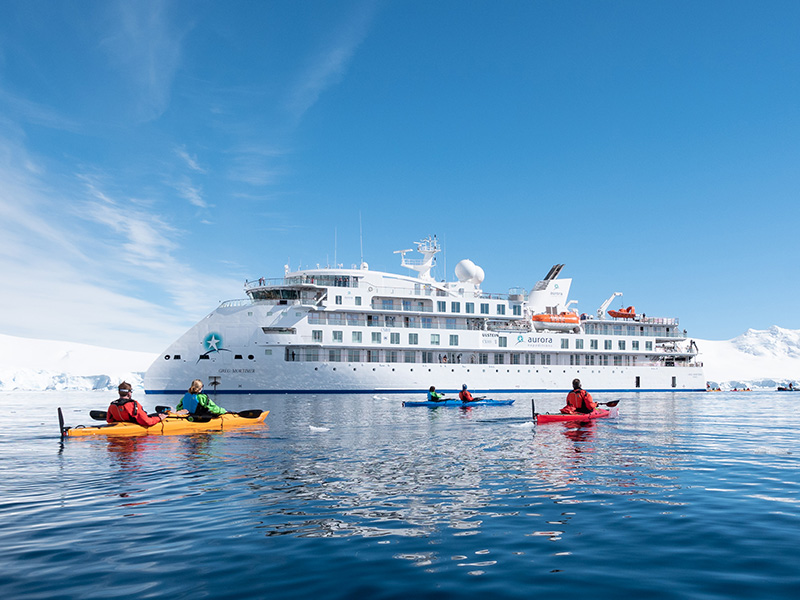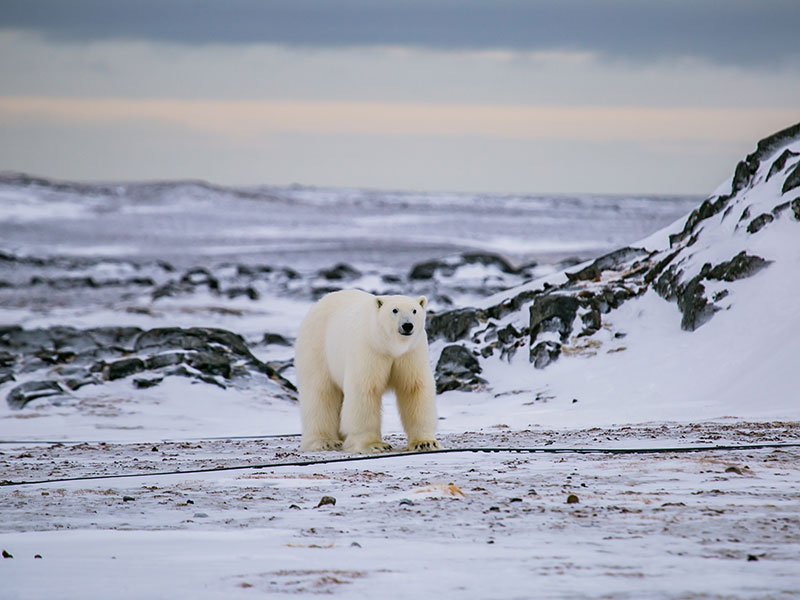Category: Arctic (page 2 of 3)

Ever wondered what activities and experiences might be on offer on an expedition cruise to the Antarctic? Whether it’s a taste of adventure on land, or on the water, when you cruise with AE Expeditions there’s a whole host of incredible experiences to get stuck into when you venture to the polar regions, such as the polar plunge, which, exactly as the name suggests, is not for the faint of heart! Below we’ve chosen five of our personal favourites, which ones will you be trying? Snorkelling It may spring to mind as a holiday activity to enjoy in tropical waters, surrounded by colourful fish, but did you know it’s a popular experience in the polar regions as well? It’s a great way to get up close and personal with seals as they rest on ice floes, as well as an opportunity to see penguins swimming. But perhaps the most impressive thing about…

The elemental forces that continue to shape this geothermal wonderland are a constant reminder of nature’s artistry and power. If you are lucky enough to have booked a trip to Iceland, then be sure to venture as far and wide as possible to enjoy the highlights we’ve put together here for your visit. Golden Circle Iceland’s most well-known tourist route takes its name after Gullfoss, aka the ‘golden waterfall’, and straddles the tectonic plates of North America and Europe on the North-Atlantic Ridge in Thingvellir National Park. Take the opportunity to channel your inner cowboy by saddling up on an Icelandic horse to take you across this vast landscape in style. Make sure to head over to the Strokkur Geyser which erupts up to 130ft every 5-10 minutes! Dettifoss Waterfall Accessible from the north side’s Route 862 and one of the main stops on the Diamond Circle Tour, Dettifoss in Vatnajokull National Park is Europe’s second most powerful waterfall. The 144ft crescendo ends with a colossal crash into Jokulsargljufur Canyon below, creating one of Iceland’s most spectacular and dramatic…

It’s not just the sheer magnitude of Antarctica and the Arctic Circle that commands a traveller’s attention. The planet’s polar regions are nature’s canvas for a colour scheme not seen anywhere else on earth! Glaciology Optics Glacial ice is a very different beast from the cubes floating around in a summer cocktail. The eye-popping blues, turquoises and aquamarines owe their super cool looks to the ice density of glaciers which absorb every other colour of the spectrum, except blue. Crystalline structures compacted over aeons channel blue light in a different way to what human eyes normally interpret ice properties. When glacial ice initially freezes, it fills with air bubbles. As that ice is buried and compressed underneath younger ice on top, the older ice starts to take on a blue tinge. As the ice grows denser, the bubbles eventually reduce to tiny levels. Without the scattering effect of these air bubbles, light can penetrate…

It’s been several years since I last travelled to the Arctic, mainly due to a certain pandemic which has stopped anyone travelling anywhere for the last couple of years! So, when a last-minute opportunity arose to join a select group of agents aboard the Silver Cloud for a 6-night expedition cruise around Svalbard, I jumped at it! I would like to say the Arctic welcomed me back like an old friend, but it was actually the opposite! We landed in Longyearbyen in 40-knot winds, which were so strong they blew the aircraft door open! It felt a bit like the Arctic was angry with us for staying away so long! As we arrived at the port our expedition leader greeted us; “we normally like to do the Silversea bit first, and then the expedition. But today it’s going to be the expedition bit first, and then Silversea!” It transpired the wind was too strong…

The overland safari is one of the best-known and most iconic travel experiences in the world today. Its popularity and fame are in part due to its conception around the art of photography itself; the wildlife encounter that must be shared. The safari sits as an experience for most bucket lists and is of course framed around the observation of the so-called Big Five animals of Africa. The lion, rhino, Cape buffalo, elephant and leopard. It’s a word that immediately conjures up very specific visual reference points, learned from glossy travel brochures, glorious high-definition nature documentaries and first-hand experiences. But the safari, as with everything in travel, has evolved as the appetite for discovery has widened. And in this blog, I take you to a very faraway place from the Big Five of Africa. A place that defines the phrase, ‘off-the-beaten-track, and one that is rarely seen at the dinner…

With 22 years of leading Polar expedition cruising behind them, Poseidon are one of the finest operators we work with. We look at some of the reasons that set them apart from the rest and why you should consider them when planning your Antarctica adventure… Small Expedition Vessel It may be an obvious statement, but the vessel you choose to embark on an Antarctica cruise needs to be able to comfortably match the nautical challenges that the unforgiving continent presents. Constructing a vessel capable of facing the harsh climates of the world’s last wilderness is no easy feat but to do so without compromising on luxury comforts for passengers is an incredible accomplishment – and that is exactly what Poseidon’s M/V Sea Spirit offers. Truly one of the finest ships that sail the Antarctic waters, the Sea Spirit caters for only 114 guests, who can enjoy a smooth sailing experience whilst staying in spacious,…

If you haven’t been to the Polar regions, Svalbard is the perfect place to start, it offers everything from incredible wildlife, fascinating human history and some of the most spectacular glaciers and Arctic landscape on the planet. It is often known as Spitsbergen, the name of the archipelago’s largest and only permanently populated island, Svalbard is an archipelago that could easily be described as an Arctic fairy-tale of a destination. It’s a dramatic wilderness of glaciers and mountains, ice fields and barren tundra, extremities of light and dark, and is home to more polar bears than people, yet people it has – making this a destination in which you can truly experience life in the high Arctic. Polar bears Search for the mighty Polar Bear – also known as the King of the Arctic – There are now estimated to be around 3,000 bears in the area of Svalbard and Franz Josef land. Polar bears hunt on sea ice, and with over 100,000km of total coastline…

Whatever else one might come to Spitsbergen for, one reason must surely be to see the mighty polar bear or hopefully even two or three! So, from the moment we were onboard our ship for our Svalbard cruise we were constantly on the lookout for one of these incredible animals. With their vast stature and amazing pearly white coat, designed by nature to keep out the very worst of the freezing temperatures of the Arctic, these majestic creatures are actually waterproof too! Great for when a dive upon some unsuspecting prey was made to ensure something for dinner, or indeed the odd swim. There was a certain rivalry between the watchers as to who might spot a bear first, forgetting that it was far more likely that an experienced member of the crew might well have keener eyes than us ‘landlubbers.’ We had been on the ship now for a couple of days, sailing slowly along the…

‘Arctic’ comes from the Greek word for bear; ‘Arktos’ and it is believed that the name refers to two constellations that can be seen in the northern sky – ‘Ursa Minor’ (Little Bear) and ‘Ursa Major’ (Great Bear). This beautiful ice-cold region is the northernmost part of our planet; a remote corner of the world inhabited by indigenous arctic people called ‘Inuits’ and admired by visitors for its incredible otherworldly landscapes and extraordinary wildlife. A place so special that it contains around 10% of the world’s fresh water. Inside the Arctic, there is at least one day a year of entire darkness, and one day a year of entire sunshine. Another particularity of the Arctic is that the sea ice that keeps the polar regions cool also helps moderate the global climate. The ice has a bright surface and 80% of the sunlight that enters is reflected back into space….

While the polar regions of the planet are more accessible than ever, the harsh landscapes of the Arctic and Antarctica still have many secrets to divulge. Countless brave men and women led the way, forging a path of discovery amidst danger, that has made it possible for average adventurous travellers to follow in their footsteps today. From the trailblazers who made their way to the poles a century ago, to the modern-day explorers who still prove the planet has much to discover, these are the nine greatest polar explorers in history. Ernest Shackleton Sir Ernest Shackleton is one of the most inspirational polar explorers in history, yet never actually reached his goal – the South Pole. Shackleton led three separate expeditions to Antarctica, the most famous being the Imperial Trans-Antarctic (Endurance) Mission in 1914 in which he attempted to be the first to cross Antarctica from one side to the other, via…










